Guided movement meditation for stress relief invites you to slow down and reconnect with your body through gentle movements and calming cues. This practice offers a simple way to release tension and cultivate a sense of peace, allowing you to navigate the challenges of daily life with more ease. So, let’s take a deep breath and get started on a journey toward relaxation and clarity.
Understanding Guided Movement Meditation
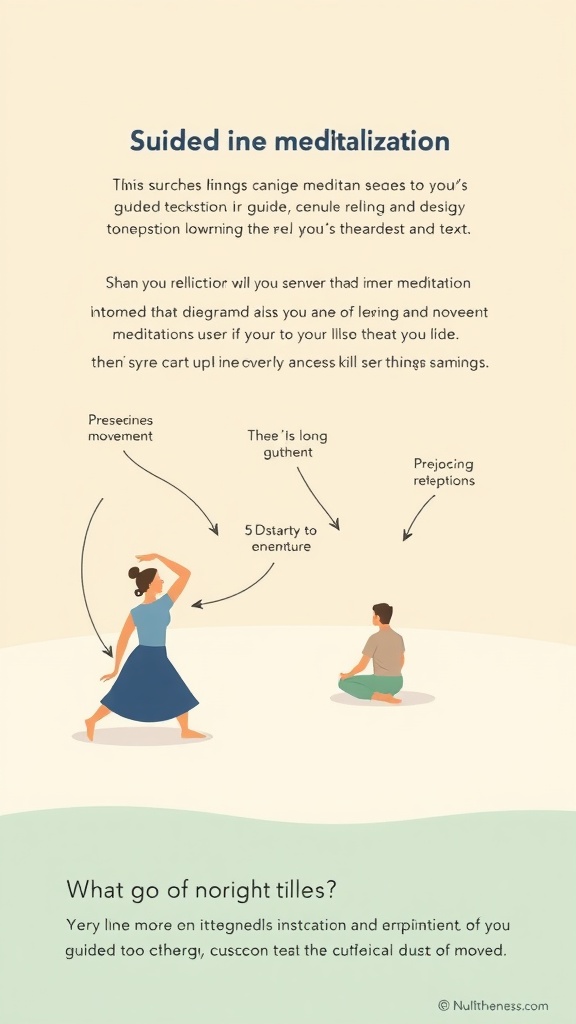
Guided movement meditation combines physical movement with mental focus. It’s a gentle way to relax while encouraging mindfulness. In the image, we see a person practicing movement meditation, highlighting the connection between body and mind.
This practice often involves following a guide who helps you through each step. The focus is not just on the moves but also on your breathing and awareness. As you move, you can release stress and tension, creating a sense of peace.
One key element is to listen to your body. If something feels uncomfortable, it’s okay to modify the movement. The goal is to find a rhythm that works for you. This encourages a deep sense of relaxation and helps ground you in the present moment.
Guided movement meditation also allows you to connect with others. In group settings, sharing these experiences can deepen your practice and create a supportive community. As you explore this meditation style, remember that it’s all about finding what resonates with you.
Creating a Calm Environment for Meditation

To truly engage in guided movement meditation for stress relief, the environment around you plays a big role. The image captures a serene space designed to promote relaxation and focus. The soft lighting and natural elements create an inviting atmosphere.
Notice the plants in the corners? They are not just decorative; they bring a sense of life and vitality to the room. Greenery can help reduce stress levels, making it easier to connect with your inner self.
The floor cushions invite you to sit comfortably. Choosing soft, inviting seating is essential for maintaining comfort during longer meditation sessions. This cozy setup encourages you to settle in and let go of any distractions.
Natural light filters in through the windows, casting gentle shadows. This kind of light can be uplifting and calming at the same time. Aim for a space that feels open and airy, allowing you to breathe and relax deeply.
Lastly, keep your meditation space free of clutter. A clean, organized area helps your mind to clear as well. This is your dedicated space for mindfulness, so make it as inviting as possible!
Simple Movements to Begin Your Practice
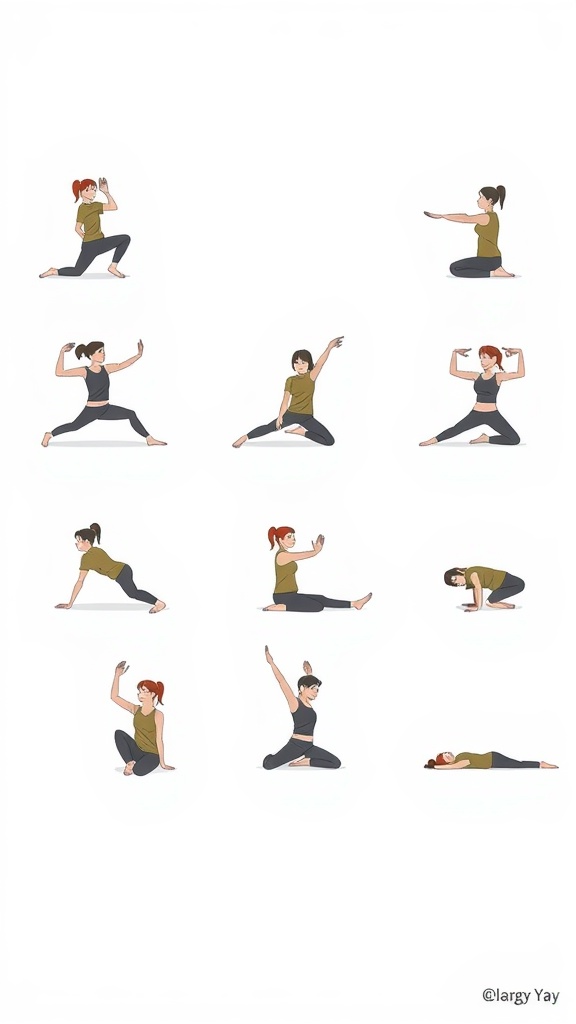
In the image, you can see various simple movements that are perfect for starting your guided movement meditation practice. Each pose is designed to help you connect with your body and release built-up stress. These movements are accessible and can be done by anyone, no matter your fitness level.
The first few positions encourage gentle stretching and awareness of your body. Notice how the figures demonstrate reaching out, bending, and twisting. These motions help to improve flexibility and promote relaxation. They also invite you to breathe deeply and mindfully as you move.
As you progress through these movements, pay attention to how your body feels. Are there areas that feel tight or tense? Allow your breath to guide you, releasing tension with each exhale. This practice is all about being present and listening to your body’s needs.
Incorporating these simple movements into your routine can set a calming tone for your day. Start slow, and remember it’s not about perfection, but about taking time for yourself. Enjoy each moment as you explore the connection between your body and mind.
Benefits of Movement for Stress Relief

Movement is a powerful tool for stress relief. In the image, we see a group of people engaging in a dynamic outdoor activity, surrounded by stunning natural scenery. This setting highlights how movement in nature can enhance our mood and overall well-being.
The individuals in the image appear to be participating in a guided movement meditation. This practice combines physical movement with mindfulness, allowing participants to release tension and feel more connected to their surroundings. By focusing on the present moment, they can let go of worries and stressors.
Engaging in movement not only boosts your physical health but also elevates your mental state. The fresh air and beautiful landscape amplify the benefits, making it easier to relax and unwind. Whether it’s jumping, stretching, or simply being active, these movements promote the release of endorphins, the body’s natural stress relievers.
Moreover, completing a guided movement session can create a sense of community. The group activity fosters social connections, which are essential for emotional support. The energy from those around you can be contagious, encouraging each person to push through barriers and embrace the joy of movement.
Combining Music and Movement for Deeper Relaxation

In today’s fast-paced world, we often overlook the power of music and movement to help us unwind. Just take a look at the image—people are gracefully moving together in a bright, open space. The soft sunlight streaming through the windows creates a warm, inviting atmosphere. This setting perfectly captures the essence of combining music and movement for relaxation.
When we engage in guided movement meditation, the rhythm of the music can enhance our experience. It’s not just about moving; it’s about feeling. The energy in the room encourages participants to let go of their daily stresses. Each step and sway becomes a release, allowing the mind to settle.
Imagine the soothing melodies harmonizing with gentle movements. The music sets the tone, leading everyone into a shared moment of peace. It’s a reminder that we can connect with ourselves and others through the simple act of moving to music.
Using Visualization to Enhance Movement

In the image, we see a person engaged in a graceful movement, their body positioned elegantly as they interact with flowing lines of light. These vibrant trails symbolize energy and intention, making a powerful visual statement about the connection between mind and body.
Visualization can play a huge role in movement meditation. By picturing the flow of energy, like the light in this image, you can enhance your practice. Imagine each movement creating a ripple of calm, gathering stress and letting it go.
When you visualize your movements, you create a mental map that guides your actions. This can help you feel more centered and connected. Picture yourself dancing through your worries, just as the light dances in the air.
Incorporating visualization into your movement can make your practice more immersive. It’s not just about the physical action; it’s about how you feel during it. Consider the emotions you wish to evoke—peace, joy, or even release. Let these feelings guide each movement.
So the next time you meditate on movement, take a moment to envision how your body interacts with energy. Like the light in the image, let your movements flow freely and effortlessly.
Guided Meditation Techniques for Beginners
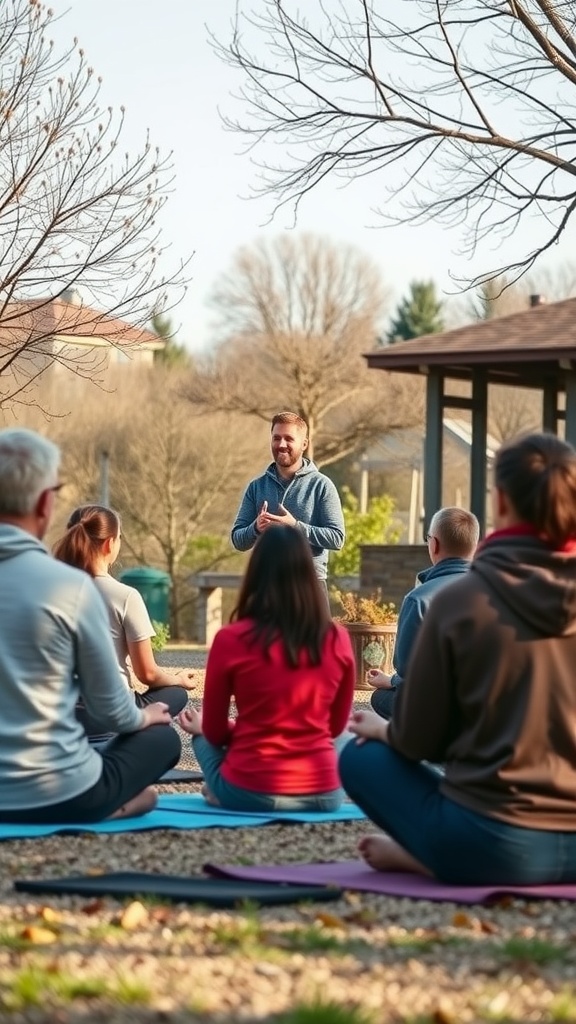
In the image, we see a group of people sitting on colorful mats, engaged in a guided movement meditation session. They are outdoors, surrounded by the serene beauty of nature, which enhances the calming atmosphere. A friendly instructor stands at the front, demonstrating a relaxed and supportive demeanor, making it easier for beginners to feel at ease.
This setting is ideal for beginners to explore guided meditation techniques. The instructor likely offers simple movements combined with breathing exercises, encouraging participants to connect with their bodies and the environment. This approach not only helps in reducing stress but also promotes mindfulness and presence.
Outdoor sessions provide an enriching experience, as natural surroundings can elevate the meditation practice. The trees and clear sky create a peaceful backdrop, inviting participants to let go of their worries. It’s a perfect opportunity to focus on gentle movements, allowing the body to release tension.
For those new to meditation, starting with guided sessions can be very beneficial. The instructor can provide cues on when to breathe deeply and how to move mindfully. This structure helps beginners stay focused and engaged, making it easier to cultivate a regular practice. Overall, finding a supportive community in a beautiful setting like this can greatly enhance the meditation experience.
Incorporating Breath with Movement
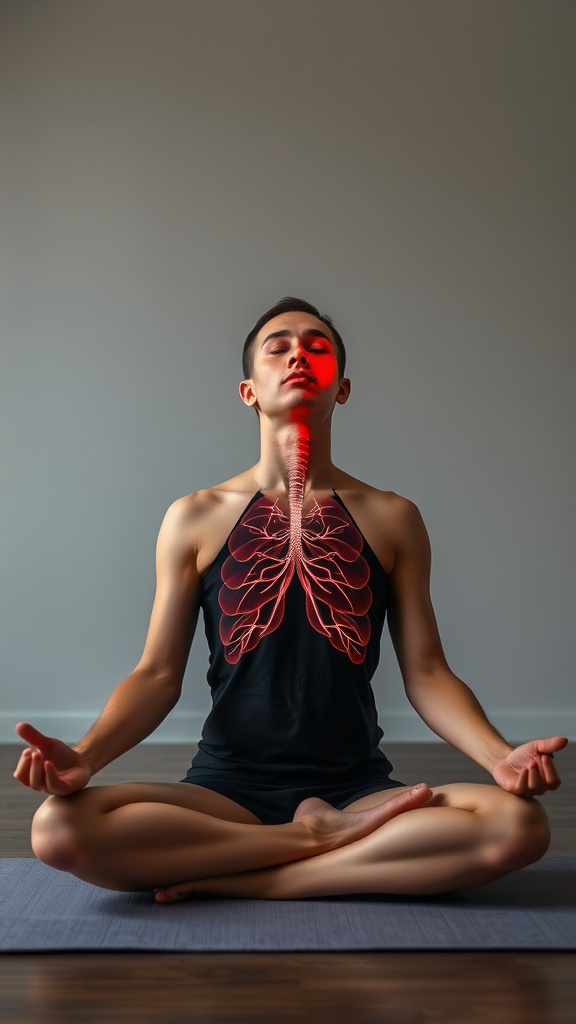
In the practice of guided movement meditation, breathing is essential. The image beautifully captures a person in a meditative pose, emphasizing the importance of breath in movement. The highlighted drawing of the lungs and spine symbolizes the deep connection between our breath and physical awareness.
As you settle into your practice, focus on your breath. Inhale deeply, allowing your lungs to expand fully. Visualize the air moving through you, energizing each part of your body. Exhaling slowly helps to release tension and stress. Notice how your body feels as you breathe; this mindfulness enhances your overall experience.
Movement should flow with your breath. When you inhale, consider lifting your arms or stretching your body gently. As you exhale, allow yourself to soften and relax into the ground. This rhythm creates a sense of harmony and encourages a deeper state of relaxation.
Incorporating breath with movement not only calms the mind but also boosts physical awareness. It helps you tune into your body’s needs, making it easier to let go of stress. So, take a moment to breathe and move, allowing the two to work together.
Exploring Different Styles of Movement Meditation
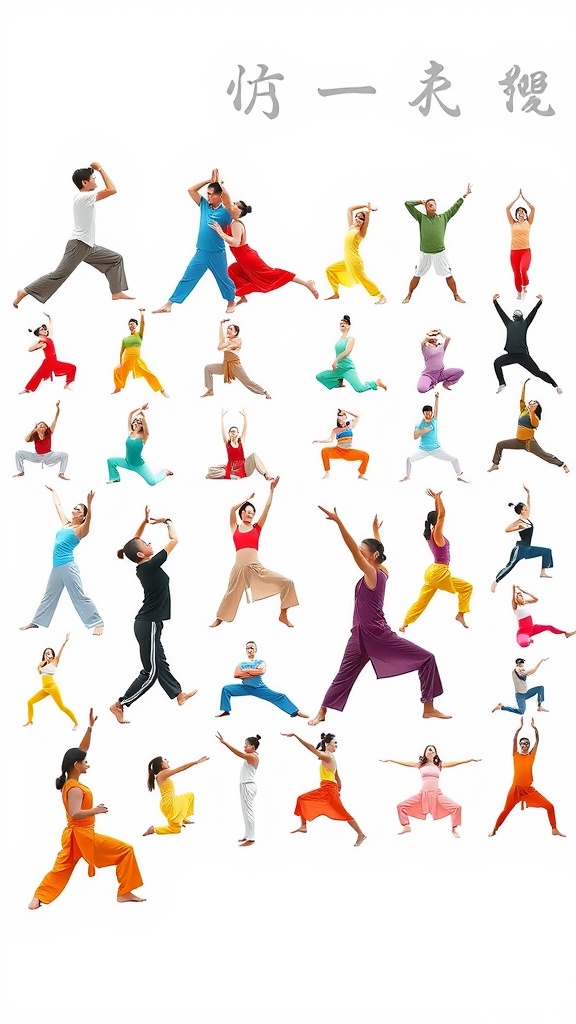
Movement meditation is a delightful way to relieve stress while keeping your body active. The image above showcases a variety of individuals engaged in different styles of movement meditation, highlighting the joy and freedom it brings. Each pose represents a unique expression of energy, flow, and connection to oneself.
From flowing dance movements to structured poses, there’s a style for everyone. You might notice some participants embodying a sense of grace, while others display dynamic energy. This diversity not only makes movement meditation appealing but also allows each person to find what resonates best with them.
Incorporating different styles of movement can enhance your meditation practice. For instance, you might explore Tai Chi for its gentle, flowing movements, or try more vigorous dance-based meditation to release pent-up energy. Each approach brings its own benefits, helping to ease tension and promote relaxation.
Ultimately, movement meditation fosters a deeper connection with your body and mind. As seen in the image, no matter your background or experience level, you can find freedom in movement. Whether you’re dancing, flowing, or simply stretching, the key is to enjoy the process and let go of stress.
Integrating Meditation into Daily Life

In today’s busy world, finding moments to pause can feel challenging. The image captures a person in a peaceful state, balancing on one leg in an outdoor setting. This simple yet effective pose reflects the essence of guided movement meditation. It encourages us to incorporate mindfulness into our daily routine, even when life feels hectic.
Practicing meditation doesn’t always need to happen in a quiet room. You can embrace it anywhere, just like the individual in the photo. Standing barefoot on a sidewalk, they remind us that meditation can blend seamlessly with our surroundings. The key is to focus on your breath and maintain awareness of your body.
Start with just a few minutes each day. You can practice in the morning before work or during a break. Even a brief pause to take deep breaths while standing can serve as meditation. Pay attention to how your body feels in each position, grounding yourself in the moment.
Being present helps manage stress and anxiety. Over time, these little moments add up, cultivating a lifestyle that values mindfulness. Whether you’re in the park, at home, or even in your office, integrating movement meditation into your day can lead to a more balanced and calm mindset.